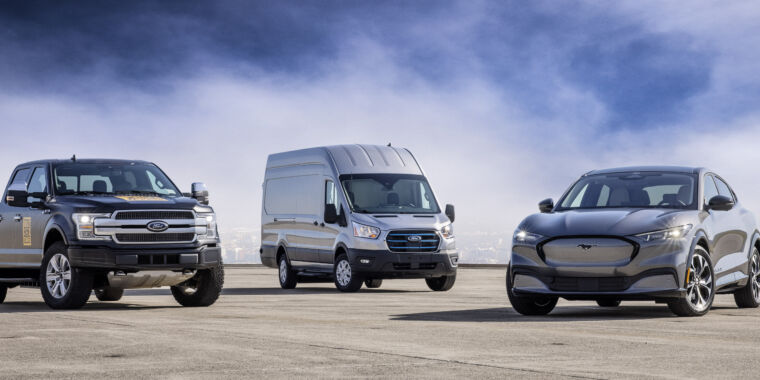Ford
Ford has scrapped plans to build some big three-row electric SUVs and is revising its North American electrification roadmap, the company announced this morning. The automaker, which comes in at a distant second to Tesla in the US electric vehicle sales charts, says the focus will now be on cheaper, more efficient EVs, including some new commercial vehicles. Those big SUVs will still show up at some time, but they’ll be hybrids, not fully electric.
Ford has never been afraid to tear up an existing plan, particularly when it comes to EVs. The Mustang Mach-E was supposed to be a much more boring compliance car until an internal skunkworks called Team Edison came up with the idea of a crossover that could only be a Ford in 2017.
But it also had big ambitions for its EVs. It created a new division, called “Model e,” to be responsible for EVs and announced it had locked up supplies for 600,000 EV batteries a year from 2023. In addition to the midsize Mach-E crossover, it created a fully electric version of its best-selling F-150 pickup truck and an electric E-Transit van.
Sales haven’t been bad, but they’re a long way from those ambitious numbers. In 2023, Ford sold 72,608 EVs in the US and looks set to beat that number handily in 2024. But it has also cut production shifts on the F-150 Lightning pickup truck and has cut back on the number of EV battery factories it planned to build. And the electric version of America’s favorite pickup is being outsold by the Tesla Cybertruck, which costs tens of thousands of dollars more than the Ford.
This February, we learned about a new internal skunkworks that was tasked in 2022 by Ford CEO Jim Farley with developing a new low-cost EV platform, likely in response to Tesla’s now-canceled Model 2—Ford has never been afraid of following Tesla’s lead. In April, Ford said it wanted to have hybrid powertrain options for all its internal combustion engines, recognizing that EV sales alone would be inadequate to meet government fleet emissions regulations.
The new plan
Ford says its new EV roadmap prioritizes a new commercial electric van, which it wants to put into production in 2026 in Ohio. It says there will be a pair of new EV pickup trucks in 2027, including a midsize truck that uses the new lower-cost platform being developed by the skunkworks team.
“We recruited the most technically skilled and creative professionals from inside and outside Ford to drive a radical change in how we develop an electric vehicle,” Farley said. “The work of this highly talented team has evolved into a critical enabler of our electric vehicle strategy. These electric vehicles will be lower cost and not compromised in any way.”
In 2027, another all-new pickup, codenamed T3, is expected to move the game on from the Lightning, with “features and experiences never seen on any Ford truck, including upgraded bi-directional charging capability and advanced aerodynamics.”
Ford is also cutting back spending on EVs, reducing from 40 percent to 30 percent of its overall capital expenditures. “We’re committed to creating long-term value by building a competitive and profitable business,” said John Lawler, Ford vice chair and CFO. “With pricing and margin compression, we’ve made the decision to adjust our product and technology roadmap and industrial footprint to meet our goal of reaching positive EBIT within the first 12 months of launch for all new models.”
And while the company scaled back some battery plant plans in the past, it now wants to move some Mach-E cell production from Poland to Michigan to take advantage of the IRS clean vehicle tax credit (which is tied to domestic battery content), with BlueOval SK factories in Tennessee and Kentucky coming online in 2025, followed in 2026 by domestic lithium iron phosphate cells from a site in Michigan. “An affordable electric vehicle starts with an affordable battery. If you are not competitive on battery cost, you are not competitive,” Farley said.
